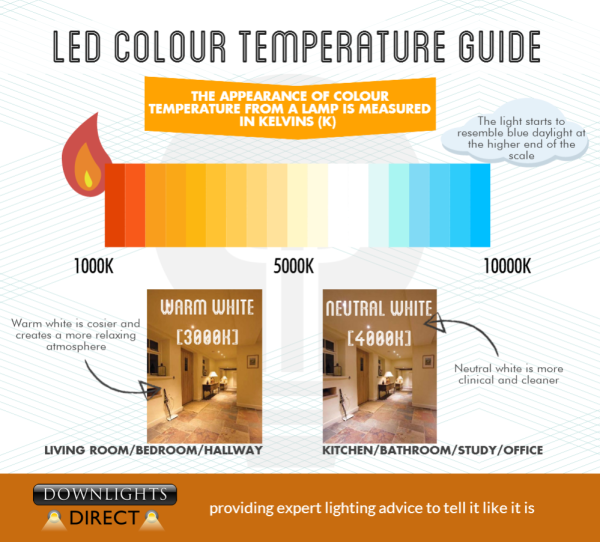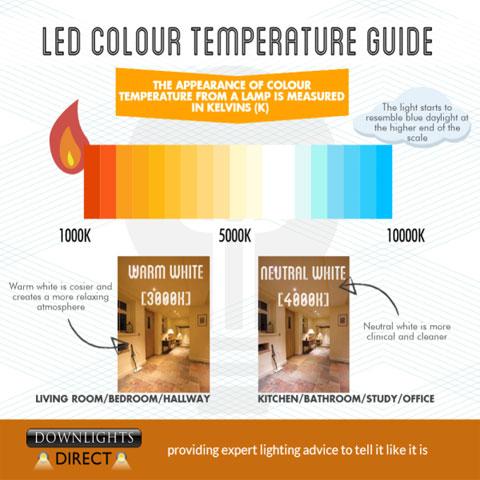Understanding the Science behind LED Lighting Colour Temperature

There are many obvious benefits to using LED lighting, from substantial energy and cost reductions to longer bulb life and lower overall heat generation, which the majority of people are aware of. However, many people are unaware that the colour temperature of their LED lights impacts the degree to which they are benefited.
This short guide is intended to make you an expert on the subject, and in doing so allow you to reap the productivity benefits of choosing your colour temperature wisely.
Lighting Colour Temperature Measurement: Beginnings
The shade known as ‘white light’ is frequently described by its colour temperature. This practice began in the late 1800s, when British physicist William Kelvin heated a block of carbon and decided to measure its hue. The carbon block was seen to change colour as it grew warmer, transforming from a dim red, through various shades of yellow, all the way up to a bright bluish white at its highest temperature. The measurement scale Kelvin developed through his experiment was named for him, becoming the Kelvin Temperature Measurement Scale. Since the Kelvin scale starts at ‘absolute zero’(-273°C) the equivalent centigrade temperature can be calculated by subtracting 273 from the Kelvin colour temperature.
Applying the Colour Temperature Scale
General illumination is measured on a scale of Correlated Colour Temperature (CCT). CCT describes the colour of light a light source produces. It makes use of the Kelvin Temperature Measurement Scale. A white light is described by its colour appearance, so it will indicate whether it’s ‘warm’ (a yellowish/gold tone) or ‘cool’ (a bluish light).
Most people are familiar with the idea of warm white or cool white options being offered by fluorescent and other light bulb ranges, but what many don’t know is that these different shades have vastly different colour temperatures. A warm bulb, which casts an orange or reddish light, will have a temperature of around 3000K. These colours are obviously commonly associated with warmth, which accounts for their name (they actually have a lower temperature on the Kelvin scale than cooler hues). A cool white bulb will actually be warmer, however, with a colour temperature of around 4000K. As it is in the lower ranger of blue colour, possessing a glare similar to ice, it was assigned its cool description irrespective of its actual heat emitting properties.
Colour Temperature Measurement Basics
It is now possible to easily measure colour temperature with a handheld metre, which takes the reading in seconds at the press of a button. This action prompts the measure to take a reading from a group of sensors behind the shield, and uses algorithms to process the Kelvin temperature reading.
To ensure that this reading is accurate, it must be pressed close to the light source or in the most neutral colour space in the room in order to ensure that the colour temperature reading is accurate. If the light is held too close to a red wall, for example, the colour reflection will skew the reading to the red end of the scale. Equally, if it’s held too close to a white object or wall, the reading will be skewed higher.
Colour Temperature Selection Considerations
One of the most common questions which arises is ‘How do I know what colour temperature I should choose?’ You may wonder whether you need a specific colour in your warehouse, office or lobby, and the answer can be quite complex. In truth, it depends on what effect you’re trying to create and the space itself. In some cases, the answer will be that all of those rooms require the same colour temperature; in others, it may be different for each…
Colour Temperature and Purpose
The colour temperature of a room or space has a dramatic effect on the people who use the space. For example, it has been proven that it is beneficial to use lighting on the cooler end of the scale for rooms used for study or reading. Studies exploring this correlation in work and classroom settings found that reading speed and comprehension improved dramatically when done under lighting with a reading of around 5500K (this falls into the ‘Day White’ category of 5000-6000K). Take a look at Seesmart’s ‘CS007 – Effects on School Children with Lighting Colour Temperature Study’ if you want to know a little more. Warehouses have also been proven to benefit from the use of brighter white lighting, as this allows workers to see objects more quickly and in more detail. For intimate settings and social areas, warmer tones tend to create a more intimate atmosphere, so tend to be better for home use.
Now that you understand the science, all that you have to do is choose your colours!

